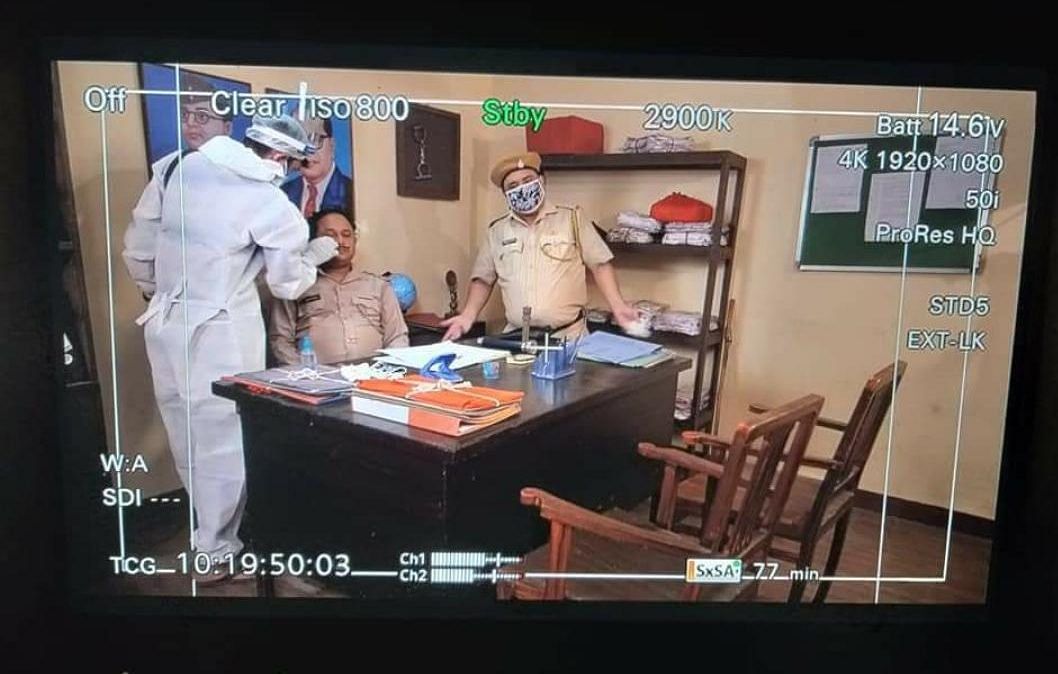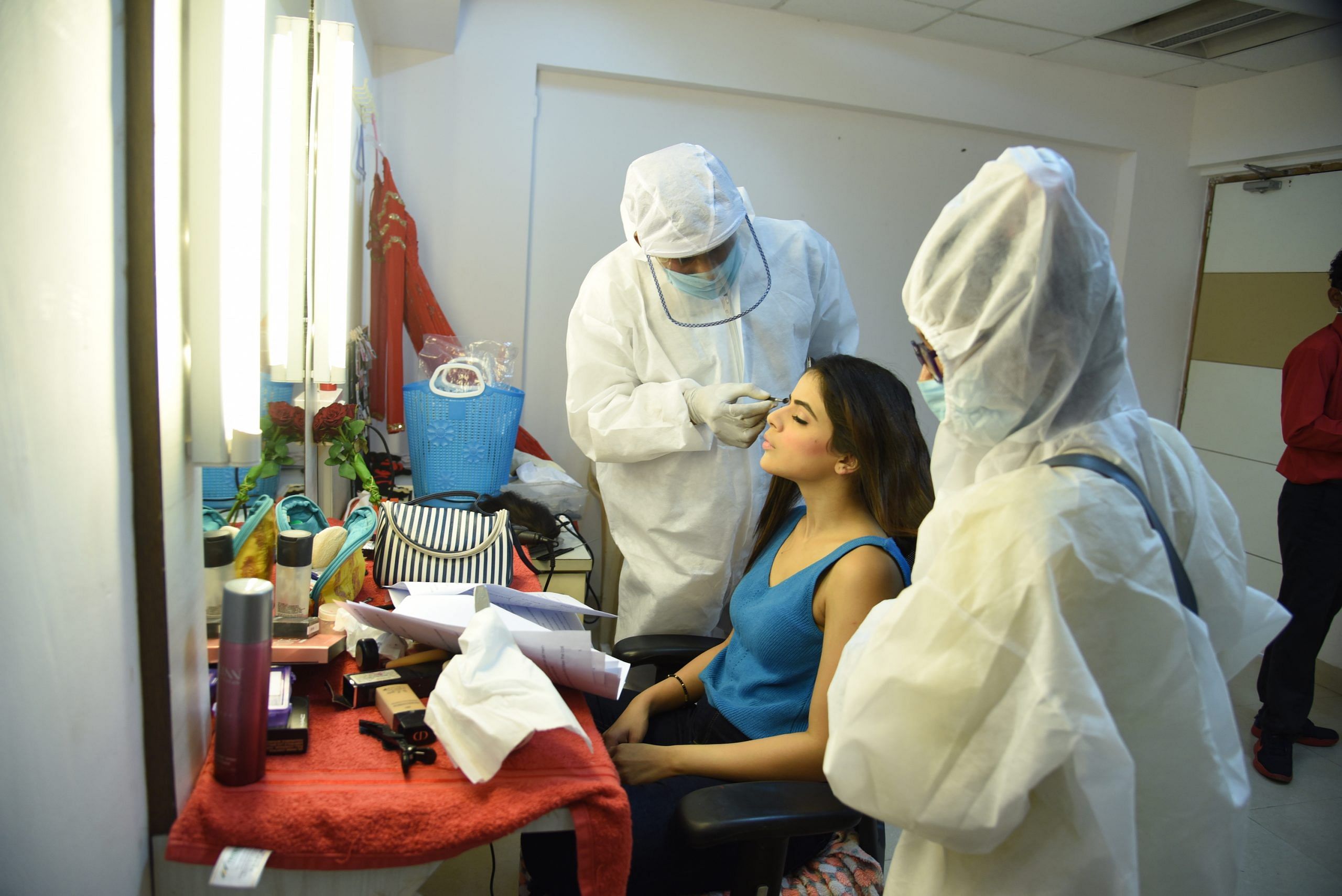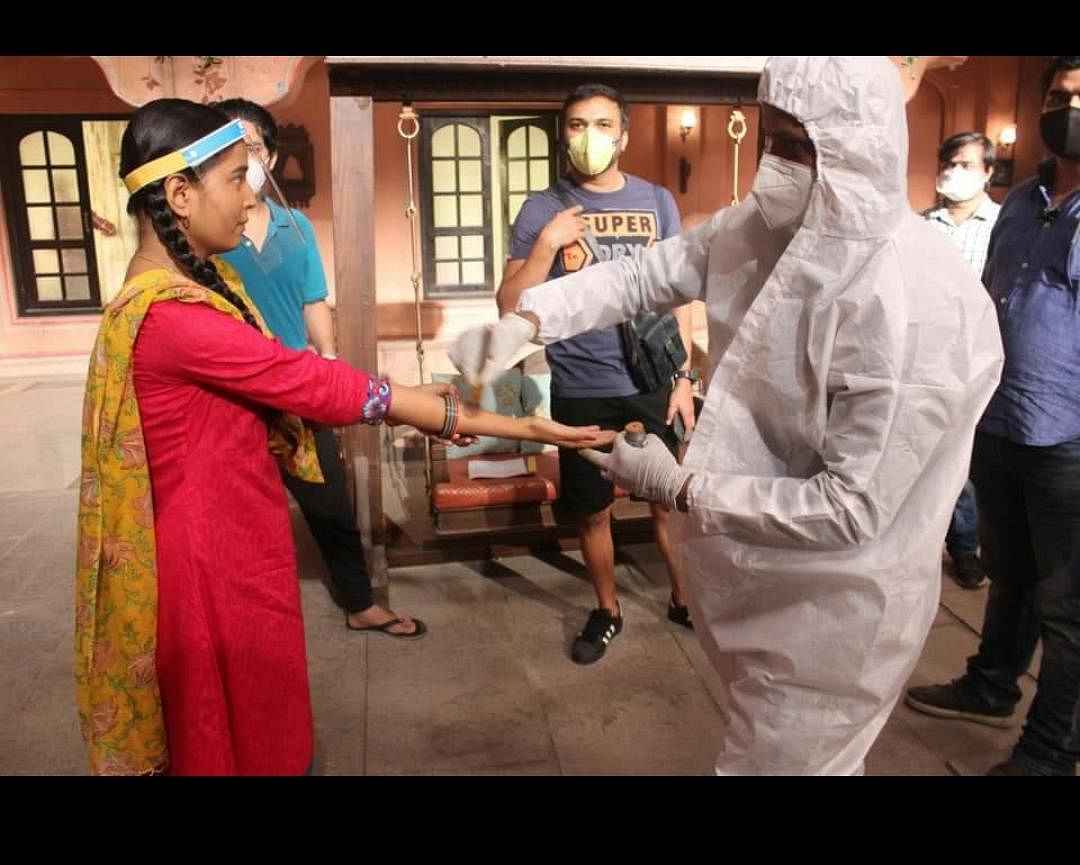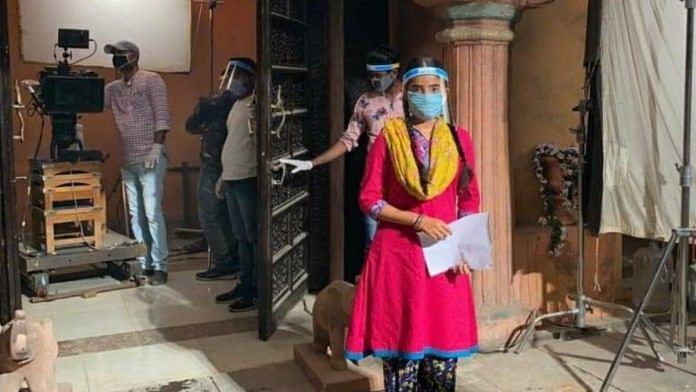Mumbai/New Delhi: It’s hard to imagine Indian daily soaps without grand wedding celebrations, large family gatherings, the occasional tight slaps or the poetic-yet-awkward intimate scenes between the lead couple of the show.
However, this will be the new reality on TV shows when they come back on air from 13 July as the industry, which resumes shooting, follows strict Covid-19 protocol.
The standard operating protocol (SOP) includes temporary and clear barriers between actors, PPE overalls for make-up artists and face shields and masks for everyone else, proper and regular fumigation of the shoot location, ensuring proper ventilation and limiting the number of people working at a given time among other measures.
Studios are returning to work after an almost 100-day hiatus, with the Uddhav Thackeray government in Maharashtra granting permissions. Industry insiders told ThePrint that more than 65 shows are being shot across Mumbai currently.
Among the popular shows set to return are Barrister Babu (Colors), Yeh Rishta Kya Kehlata Hai (Star Plus), Kumkum Bhagya (Zee TV) and Bhabiji Ghar Par Hai (&TV). Colors TV has already been broadcasting Khatron Ke Khiladi and Barrister Babu.
However, the return to silver screen is coming at a cost, say producers and directors, who cite tight staff schedules, reduced wages for labourers and longer work calendars.
Also read: ‘Non, the kiss is not dead’: French govt allows actors to go back to kissing on-screen
How different will TV look
Speaking to ThePrint, Jamnadas Majethia, chairman, Indian Film and TV Producers Council, said the much-loved wedding scenes among others can be ruled out for now.
“The new SOP clearly states that there will be limited people on the sets. Hence, there will be no grand weddings, death sequences, party sequences, sequences that involve hugging or touching… that were an important part of all shows earlier.”

Also, Sony’s Indian Idol will not be able to treat its viewers with the euphoric visuals from their auditions at which lakhs and lakhs of aspiring singers used to queue up for 24 hours hoping for a spot on the popular show.
Auditions will be held remotely, and only 30-odd people will be flown to Mumbai to participate, singer and show host Aditya Narayan told ThePrint.
“There’s something special about the audition process, which no matter how exhausting, is an exhilarating experience for contestants, judges and viewers. I am especially going to miss it,” he said.
But these subtractions don’t necessarily mean TV shows will be broadcast in a bland fashion. Anupam Santosh Saroj, who has directed shows like Naked (MX Player), is confident these restrictions will boost creativity among show makers, and will lead to finer writing and better execution.
“Especially in shows on OTT platforms, Directors are going to heavily rely on VFX and stock shots for outdoor scenes and scenes that require a crowd. Layering and compositing, and if the makers have the budget, then 3D mapping will come in massively,” he said.
Also read:Special effects & social distancing: How Ram Gopal Varma shot India’s first ‘Covid film’
Tight budgets, slashed pay
Indian Film and TV Producers Council’s Majethia told ThePrint that the TV industry has lost over Rs 400 crore in the last three months.
These struggles have been accentuated by the continuous payment of sky-high rent to studios that have refused to waive.
“I am paying Rs 7 lakh for a studio, inside which I have a set worth Rs 1 crore. We are now in talks with the studio owners and have requested them to waive 50 per cent of the rent,” said producer Keval Sethi.

With shoots of TV serials resuming, migrants who worked as carpenters, masons and handymen and had left for their hometowns in UP and Bihar, are back. They will, however, be working for a reduced pay.
“They are now working for over 12 hours and their payments have been slashed by 33 per cent. These are people who suffered the most, even during the lockdown, as they are all daily wagers and get between Rs 1,000 and Rs 1,500 per day,” B.N. Tiwari, president, Federation of Western India Cine Employees (FWICE), told ThePrint.
“During the lockdown we tried to raise some money for the workers and put Rs 3,000 to Rs 5,000 in their accounts, but in a city like Mumbai, with high living costs, this amount is very meagre,” Tiwari said. He added that the federation has been demanding that producers pay double the salaries to migrant workers to mitigate their struggle.
According to the new SOP, the production houses will also have to arrange stay for workers near sets since most most live in Mumbai’s cramped chawls with shared toilets, putting them at high risk of contracting Covid-19. However, only a few have been following this, claims Tiwari.
The new SOP also limits the number of people that can be on a set to 50, including junior artistes, dancers, fighters and extras who feature in crowds. Typically, there are about 70-80 people on set. This restriction has resulted in job losses.
“While watching the serial, many may not notice these people, but they make an important part of the show and their livelihoods depend on the TV industry,” Tiwari said.
The association now has also demanded that Rs 2 lakh be given to anyone who falls sick with Covid-19 and requires treatment. In case of a fatality, Rs 25 lakh will be given to the family of the deceased.
“This was important. The workers cannot afford a Covid-19 treatment in case they catch the infection while at work. So, it was decided and an agreement was reached with CINTA (Cine and TV Artists Association), saying that if anyone in the industry, be it artist or workers, dies of Covid-19, Rs 25 lakh will be given to her family,” Tiwari said.
Also read: No kissing, no extras: How to make TV in the age of the virus
Slower pace, longer hours
Although shooting has resumed in full swing, there is still fear among artistes, producers, and directors of contracting the deadly virus, especially after two cases were reported from inside the film city.
While one case was from the sets of Mahanayak Ambedkar (Zee 5) — the actor playing the father of the lead caught the infection — the other was from the sets of Mere Sai (Sony).

Precautions have been doubled to ensure everyone stays safe.
“We are keeping a tab on the daily influx of people on the sets, and ensuring the same set of people are working together to keep risks at bay. Regular fumigation of sets, access to medical services, placement of sanitisers, usage of N95 masks, regular temperature checks, and other necessary protocols are being followed,” Manisha Sharma, chief content officer, Hindi Mass Entertainment, Viacom18, told ThePrint.
Given the limit on people working on a set, shooting now takes a longer time.
“One person, say a light-man or a spot boy, is doing the work of three people,” Majethia said.
This shortage in capacity will likely endanger the five-day week schedule in the near future. “Pre-lockdown, shows would shoot about 14-18 minutes worth of footage in a day. I don’t see that happening right now, so either length of episodes will be cut or the number of episodes telecast a week will go down,” director Suhail Tatari, who directed award-winning shows such as Kashmeer (2003), told ThePrint.
However, channels and directors claim that while shooting has been slower, they have been catching up and will be able to retain the pre-lockdown levels by creating a bank of content in advance.
Noel Smith, who is directing Ishq Mein Mar Jawan that is set to premiere on Colors TV, said they are now on track after an initial struggle of 2-3 days. “There won’t be any change as we have to adapt to the situation and deliver as promised. The audiences will get to watch their favourite shows as per the original schedule and duration.”
Also read: Is the future of cinema expensive, hygiene-friendly theatres or at-home Netflix experiences?




Mujhe bhi serial mein audition Dena h
Actor ki liye apply